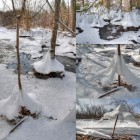Land
Wisconsin officials cut diseased trees at state park
|
Wisconsin State officials are cutting down trees in Whitefish Dunes State Park in Door County that are infected with beech bark disease. The park has lots of beech trees and those that are infected pose a safety hazard, said Linda Williams, a Wisconsin Department of Natural Resources forest health specialist. Weakened limbs and trunks can snap off or fall over during strong winds. The idea is to remove dead trees before they harm visitors or staff. Infected trees that are within 75 feet of park trails are targeted, said Arnie Lindauer, a program analyst for the park.










